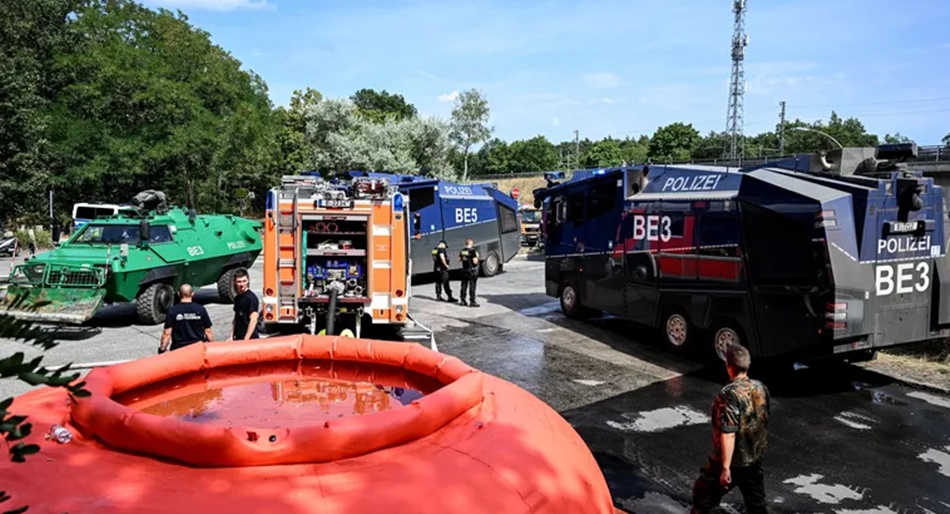
Parts of the forest are burning – the fire is still not extinguished on Saturday. / Grunewald: The situation is not yet under control
Firefighters in Berlin have been fighting a forest fire since the early hours of Thursday morning. At a blasting site in Nikolassee, a storage site for ammunition found by the Berlin police and also the Grunewald caught fire as a result of an explosion. Around 25 tons of explosive ordnance and fireworks are stored at the detonation site.
The fire brigade is on site with numerous forces and has been supported by more than 500 police officers and the Bundeswehr. Special technology in the form of several remote-controlled robots and armored vehicles that could extinguish the fire is used. The fire brigade had not been able to start extinguishing the fire for hours because of the ongoing explosions.
12.45 p.m .: Brandenburg is ready to talk in a debate about an alternative blasting site
The deputy head of the SPD parliamentary group in Brandenburg, Inka Gossmann-Reetz, expressed skepticism in the debate about alternative locations for the Berlin blast site in Grunewald. The area around Berlin is now very densely populated, the politician told rbb24-Inforadio on Saturday. “Here, too, we (…) have to be very careful not to put the people here in increased danger.” Gossmann-Reetz said: “Personally, I would also reject the idea that we transport Berlin bombs dangerously through our densely populated Brandenburg area.” Transport and vibrations are a high risk.
But she understands that Berlin’s governing mayor Franziska Giffey (SPD) is looking for a conversation with Brandenburg. Prime Minister Dietmar Woidke (SPD) will have an open ear here, said the member of parliament. The fire in Grunewald sparked renewed discussion about a possible relocation of the site.
Brandenburg’s Interior Minister Michael Stübgen (CDU) was open to talks with Berlin about the disposal of explosive ordnance: “We have good cooperation with Saxony and are of course also open to Berlin wanting to participate in our procedures for disposal of explosive ordnance in the future.”
Brandenburg’s central blasting site is located in a forest in the small town of Kummersdorf-Gut, about 50 kilometers south of Berlin. Berlin’s chief of police, Barbara Slowik, had said that because transporting old World War II bombs was very dangerous, a nearby blasting site was still needed.
11.45 a.m .: The situation is not yet under control – there is still “enormous danger” at the explosive site
The situation at the blast site in Berlin’s Grunewald is still not under control. “There is of course an enormous danger there,” said fire department spokesman Thomas Kirstein on Saturday in Berlin. There are three hotspots defined by the demolition expert on the blasting site. “They are now cooled with robot technology.” Armored vehicles and robots are used for this.
One problem is the extreme temperatures, up to 700 degrees were measured on Friday. Kirstein did not want to give any information about new measurements. “It’s under constant surveillance,” he said. This is included in the assessment. The declared goal is to limit the restricted area of currently 1,000 meters around the blasting site. This depends on how the explosives expert assesses the danger of the heat on the explosive device for ammunition and ordnance stored there.
The nearby Avus city highway and railway line remain closed. “Bahnverkehr and Avus are in a circle of 1,000 meters, but relatively on the edge,” said Kirstein. The aim is to at least release rail traffic because the route runs “at the outermost edge of the circle”.
The fire was prevented from spreading in the surrounding forest during the night. “We kept extinguishing smaller fire nests,” Kirstein said. The situation immediately around the blasting site must be constantly reassessed, for example whether it is also possible to use the fire brigade. “But that first requires a bit more safety at the blasting site.”
10.20 a.m .: Wildlife expert: Most animals brought themselves to safety
According to experts, deer, foxes and wild boars have taken refuge in the fire in Berlin’s Grunewald. “Most wild animals are purely flight animals. As soon as there is danger, for example smoke, disturbances such as explosions or fire, they flee immediately,” said the wildlife expert of the Senate Department for the Environment, Dirk Ehlert, the German Press Agency on Friday.
It can be assumed that most of the fast animals with legs or wings fled in time. Smaller species such as insects, on the other hand, would have a harder time. But they could hide underground – and in some cases survive that way.
According to estimates by the wildlife expert, there are over 1,000 animal species in the Grunewald. It is still uncertain how much of the forest area is actually affected by the fire, whether it is a ground or wildfire and how many animals were injured on a larger scale, said Ehlert.
8.15 a.m .: The situation calms down – Avus and the railway line are still closed
The fire in the Grunewald forest in Berlin has not been completely extinguished even two days after it broke out – the nearby Avus city motorway and the railway line remain closed. According to the fire brigade, a decision on when and whether the routes can be opened can be expected around Saturday noon at the earliest. It continues to burn at the blast site, but only within a defined area. Smaller fires would be extinguished there. There are currently no major sources of fire in the forest outside the blast site.
In the night to Saturday there were no more explosions, it was said. Remote-controlled robots to explore the exclusion zone were withdrawn due to the more relaxed situation at night. Exploration of the area should be resumed on Saturday morning.
Although the flames around the Grunewald site have largely been extinguished, the danger has not yet been banned, especially for the emergency services. According to the police, the ground on the site there was still up to 700 degrees hot in some places on Friday. To reduce the risk of further explosions from remains of ammunition, these areas must be cooled with water. The fire brigade and a special company used a fire fighting vehicle. Some storage sites for dangerous explosives have always been constantly cooled with water, nothing happened there.


